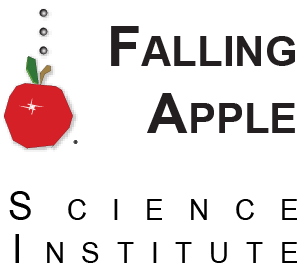Falling Apple's innovative approach to mapping out a science education.
The Periodic Table of the Sciences is Falling Apple Science’s original, innovative approach to mapping out a science education. The purpose of the Period Table is, to quote Lewis Carroll, to help us “begin at the beginning”. Too often we find ourselves enthusiastically jumping into a science curriculum or project without proper consideration of what knowledge is really necessary to understand it.
atoms
Kepler
laws
table
tectonics
theory
dating
fication
microbes
& animals
The Periodic Table of the Sciences was developed to organize and prioritize subjects and levels of study. We call it a “periodic table” as a tribute to Mendeleev’s innovation and because it serves a similar function. Our table places each idea of science into an integrated structure that shows what prior knowledge it rests on, and which major theory it leads to.
A quick glance at the Periodic Table tells you what level of study a particular idea or activity falls under. For example, Newton’s Laws are presented after the study of Astronomy, and after the study of Galileo’s Laws of Terrestial Motion, Statics, and Simple Machines. To build real scientific knowledge, a course of study should begin with Column 1, Stage 1: Astronomical Observations. This leads to astronomical calculations, then to Geocentric Theory. Without the Periodic Table for guidance, anything “science-y” seems perfectly reasonable any time.
The Periodic Table of the Sciences maps the historical progression and integration of scientific knowledge. Concepts appear in a hierarchical order, encouraging students to actively use knowledge gained in earlier stages to confidently engage new challenges. Students learn to see for themselves the causal connections in nature that led scientists to their discoveries. It answers these key questions: On what prior knowledge does an idea depend? And where does the idea lead?
The columns of the Periodic Table depict the six major theories necessary for a basic understanding of science. The order of the columns reflects the fact that each theory is a prerequisite for the next. Theories build on each other, starting from Astronomy on the left side and continue through the sciences until you reach Biology on the far right.
The rows of the Periodic Table show the increasing levels of complexity of each field of study. Investigation starts at the bottom with observations and basic concepts which then become more advanced as one moves up through the levels.
Ultimately, Falling Apple Science will fill in each of squares of the Periodic Table with level-appropriate material to provide a complete science education. Some of the work is complete. The bottom-most Astronomy square, Stage 1, comprises three books and two devices. The books are Sun, Moon, and Planets, The Stars, and Seasons and the Celestial Sphere. Special apparatus had to be invented and built to understand and convey the information in these books, namely The Sun Puppet and The Horizon Globe.
These books and devices give a unique human-centered perspective on the observations of the sky that can’t be found anywhere else. Work on Astronomy Stage 2 is also complete, with the fourth book of the series, Early Astronomical Measurement I, and Book 5: Early Astronomical Measurement II.
Progress continues. We have completed detailed outlines of the Chemistry and Geology verticals, and are working on Stage 3 of Physics I, Galileo's Kinematics.
If you would like to see a continuation of this work on the Periodic Table of the Sciences, please consider making a tax-deductible contribution.
